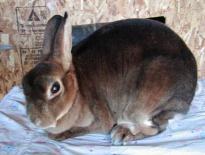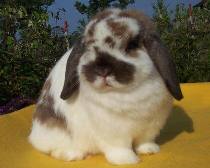
Grooming is best done at home, before a show. On the day of the show, many exhibitors mist their rabbit lightly with a water spray bottle and work the coat till the water is gone, to remove dead hairs and static. On the rollback coated breeds, such as Holland Lops, Mini Lops, and Netherland Dwarfs, you can use a soft brush to remove dead hairs. Flyback-coated breeds like Polish, Tans, New Zealands, Californians, and more need very little grooming and do not ever need to be brushed, except perhaps in extreme molt.
Rex-coated breeds should not be brushed, ever. It can damage the desirable “springy resistance” of their fur.
In almost no circumstance should a rabbit be given a full-blown bath. Bathing destroys the natural properties and oil in the coat, and leaves the rabbit looking ragged. Trust me, I’ve seen it.
Grooming is regulated by American Rabbit Breeders Association. So it is important that you do not add anything to coat your rabbit’s fur to add an artificial luster or texture. Luckily, you can have great success with just the basics: nail clipping, brushing, and removing stains.
How To Clip Rabbit Toe Nails
Start by trimming toenails, if you didn’t do this at home. I always mean to, but things can get busy in the barn just before a show. You can use cat nail clippers or small dog clippers. Cradle the rabbit in your arm like a baby. Hold his feet one at a time with your cradling hand. Pull back the fur and clip beyond the quick. The quick is easy to see in white-nailed rabbits, so practice on them first. After a while, you can estimate where the quick is on dark nails. Or, you can ask a friend to hold a flashlight behind the nails to illuminate the quick. If you cut the nails too deeply, they will bleed. It will look more serious than it is. Either use styptic powder to stop the bleeding or put the nail into some flour or cornstarch to begin the clotting. For long nails, clip just the tips and repeat again in a week. That will allow the quick to recede gradually. Don’t forget the “thumb” nail on the front feet. They can get very long before you realize it, curving in, making it difficult to clip.
Brushing a Show or Pet Rabbits

Not all rabbit breeds need brushing. Breeds with short, slick, flyback coats usually do not need to be brushed. In fact, excessive brushing can damage the hairs and spoil the coat. Rollback coated breeds such as Netherland Dwarfs and Holland Lops have thicker and longer fur that can sometimes benefit from a brushing or combing. Of course, wooled breeds like Angoras, Jersey Woolies, and American Fuzzy Lops need more thorough grooming.
Use a 4″ rabbit brush (or cat slicker) on your rabbit’s coat. Take care to remove as much dead fur as possible. Make sure you remove any dried fecal matter, knots, hay, and other stray objects from the fur as you brush. Smaller rabbit brushes are made especially for faces and smaller areas. You can also snip knots or fecal matter and bedding out with small scissors.
How to Remove Stains from a Rabbit Coat
Remove stains next. I like to try peroxide or white alcohol first. It is especially effective on food stains. When I had Mtn’s Doni, he kept a food stain between his eyes because his muzzle was so short, he had to press his face against the feeder to get pellet out. But the peroxide cleaned it up perfectly at the beginning of each show. Some breeders apply the peroxide or white alcohol to the stain
You can also use a rinse-less rabbit shampoo with whitener such as Classicoat. Spray the stain and use a towel to massage the fur. Then towel dry. Don’t forget to re-brush that area when dry. I find that the shampoo works best over several days’ use. You may want to start the process during the week before the show.
Final Grooming Touches Before a Show
After the rabbit is brushed, clipped and stain free, dampen your hands slightly and rub down both sides of his or her body to remove dead fur. Continue you rub down and back until no more dead fur flies free. I also use a static-reducer from Fox Allen Farms. Pandora Allen gave me a sample last fall and I love it. It especially helps fur that is just starting to open, that is, is beginning to die in preparation for a molt. And it makes longish fur look a lot neater.
